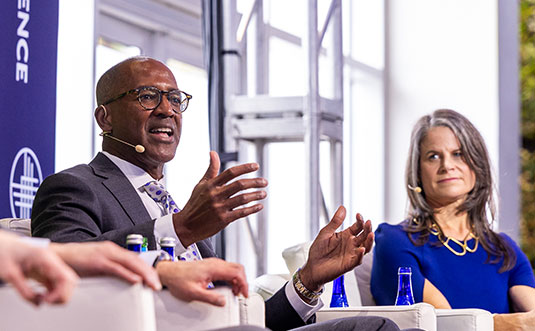05/08/2025 — American workers continue to face a retirement crisis. We know many workers need to save earlier in their careers and more throughout their careers. But we also know the need is stronger than ever for workers to have a plan for how they will live off their savings once they retire.
Today, the old “three-legged stool” of retirement income—pensions, savings and Social Security—is wobbly. Many employees no longer have access to defined-benefit pension plans that once provided retirees a source of steady income, and those who do may still see their pension income decline as average employee tenure declines. Market volatility, which is common these days, increases the risk around personal savings. And with Social Security, the future is anything but certain.
On top of this stool, longevity risks are adding to the pressure on retirees’ income plans. It’s no secret that people are living longer, but the increasing likelihood of a retiree reaching the late 90s or even age 100 means retirement income may need to last many more years than planned.
A growing need for long-term retirement security
I recently had the opportunity to participate at this year’s Milken Global Conference in Los Angeles on a panel to discuss planning for the ideal retirement. Joining me on stage for this discussion were three financial industry leaders: Christine Benz from Morningstar; Thomas Lee from the New York State Teachers’ Retirement System; and Rebecca Tadikonda from Athene.
At Nationwide, retirement success means helping more Americans prepare for and live a secure, dignified retirement—even when retirement lasts longer than they expect. For financial professionals like you and industry partners like us, that last part is growing in importance as more clients face the financial challenges that come with living longer lives.
Think about this: the number of Americans reaching the “Century Club”—living to age 100 and beyond—is expected to grow four-fold over the next 30 years according to the U.S. Census Bureau. For couples, there’s a 20% chance that one partner will live to at least 100.
While only a small number of Americans will attain “Century Club” status, many more will live well into their 90s. For a client who retires at age 65, their retirement may last 30 years or more. The average retirement today is just 18 years. That means many current and future retirees run the risk of running out of money before they run out of time.
Raising awareness of longevity risk
In a recent Nationwide Retirement Institute survey, we learned that a majority of Americans (71%) don't want to live to be 100. The reality, however, is that many people are living longer than they thought. Those extra years can increase the risk of running out of money later in life. Research by the American College of Financial Services found that extending retirement by just five years—from 30 to 35 years—raises the likelihood that a retiree would run out of money by nearly 60%.
Our survey also found that around one-third of Americans said they have the financial resources to live 35 years in retirement. This may be wishful thinking, but it’s also likely they’re not considering how different the future may be from the present. For example, factoring in potentially lower investment returns—which is a distinct possibility—increases the odds of running out to money to 300%.
The reality is, less than half of Americans take into account how long they are likely to live when making decisions about saving and investing. Bringing more attention to longevity risk is one way you can stand out with clients and emphasize your valuable role as a financial professional.
Start with a conversation about reaching the “Century Club.” If people knew they would live to 100, most people in our survey said they would do things differently. Many would choose to live healthier lives and focus on their relationships with loved ones and family members. Their financial behaviors would change, too. Two-thirds of those surveyed said they would pay more attention to their finances.
Solving the retirement crisis, one plan at a time
Awareness of the longevity challenge is important, but solutions matter too. Partners like Nationwide and others in the financial industry are working to address these risks with innovative protected retirement solutions that offer savers two types of protection: principal protection and lifetime income.
Most Americans see their workplace retirement plans as their primary source for saving and investing for a secure financial future. The financial industry has done a good job developing innovative solutions around accumulation—auto-enrollment and auto-escalation features in retirement plans are helping workers save more. But it’s time to pay more attention to protection strategies and the other side of the retirement planning equation: decumulation.
In-plan lifetime income funds provide the certainty of a pension-like1 monthly paycheck, helping workers convert their savings into regular payments they won't outlive. These "auto-income" solutions offer retirees a familiar, paycheck2 stream, boosting financial confidence both in retirement and for the future.
Acceptance of in-plan protected retirement solutions is growing, but it’s incumbent on all of us in the retirement planning industry to educate and increase adoption of these options in workplace retirement plans.
Retirement security is a foundational need
As a financial professional, you have a tremendous opportunity to build lasting relationships with clients by addressing their most significant concerns about retirement—outliving their savings and achieving financial and emotional security as they get older.
Financial professionals are valuable partners in helping to solve for longevity risks. Through one-on-one interactions with clients, you can emphasize the importance of planning for a longer-than-planned retirement.
As you work with clients to help them achieve long-term financial security, solutions like in-plan lifetime income funds, guaranteed income options for annuities and long-term care insurance coverage can be key components of a comprehensive financial plan. Strategies for filing for Social Security can also be critical in helping clients maximize the benefits they have earned and strengthen their ability to stay financially secure over a long retirement.
Watch a replay of the panel discussion from the 2025 Milken Conference. You can also read more about solutions for longevity risk in this essay I wrote for the Milken Conference, in collaboration with someone who’s learning how to make the most of retirement, NFL Hall of Fame quarterback Peyton Manning.
Learn more about protected retirement solutions from Nationwide.
For financial professionals. For retirement plan sponsors.

